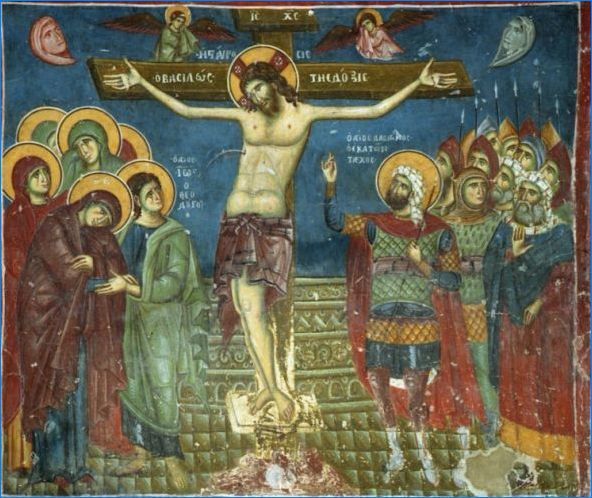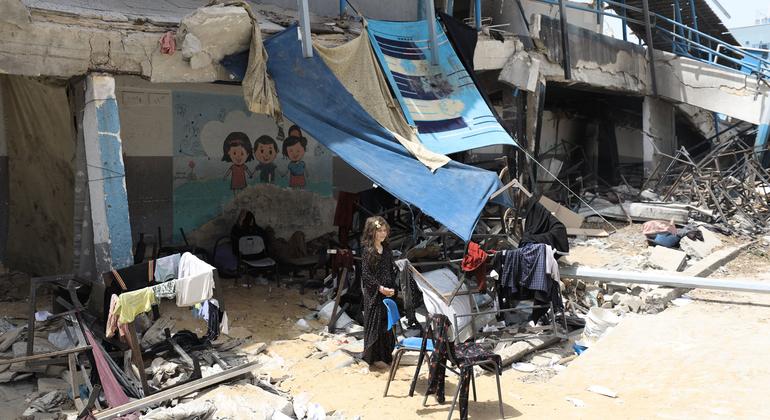By prof. A. P. Lopukhin
19:25. At Jesus’ cross stood His mother and His mother’s sister, Maria Cleopova, and Mary Magdalene.
For Maria Magdalena and Maria Kleopova, see the interpretation to Matt. 20:20; Luke 8:2, 24:18. Here the evangelist paints us another picture, which is in sharp contrast to the first: Christ entrusts His Mother to the care of His beloved disciple.
19:26. And Jesus, seeing His mother and the disciple standing there, whom He loved, said to His mother: woman, here is your son!
19:27. Then he says to the student: here is your mother! And from that hour the student took her with him.
How many women stood on the cross? Some commentators say that there are three, others that there are four. The second opinion seems more likely, because it would be unnatural to suppose that the evangelist would precisely name the sister of the Blessed Virgin Mary, when he does not name the Mother of Christ herself. At the same time, it is very natural to assume that the evangelist mentions four women standing in pairs, of whom he does not name the first two (this explains the double use of the particle “and”).
“His mother’s sister.” But who was this sister of the Blessed Virgin Mary?
There is nothing implausible in the supposition that John here means his own mother, whom, like himself, he does not mention by name out of modesty. With such an assumption, it is quite natural for John and James to claim a special role in Christ’s kingdom (Matt. 20:20ff.), as well as the entrusting of the Blessed Virgin to John, who was thus a close relative of Christ. Although the Blessed Virgin could have found shelter with the sons of Joseph, they were not close in spirit to Her Son (John 7:5), and therefore to Her.
“woman, behold thy son.” Why does Christ call His Mother simply a woman? On the one hand, He shows that from now on He belongs to all people, that the natural ties that connected Him with the Blessed Mother are already severed (cf. John 20:17), and on the other hand, He expresses His compassion for Her as to precisely as to an orphaned woman.
John then took the Blessed Virgin with him to take her to his father’s house in Capernaum—which was, of course, his intention at the time. But this intention was not fulfilled, and John, together with the Blessed Virgin, remained in Jerusalem until her death, after having spent three weeks in Galilee after the Resurrection of Christ, where he went by order of Christ (cf. Matt. 26:32).
19:28. After that, Jesus, knowing that everything has already been done to fulfill the Scripture, says: I am thirsty.
“Then”. Here the evangelist paints before us the third picture – the picture of the death of the Crucified Christ. After that, that is, after Christ had fulfilled His filial duty to His mother.
“Knowing that all things were already finished,” that is, knowing that all that was to be finished in His earthly life had been brought to an end.
19:29. There was a vessel full of vinegar. The soldiers soaked a sponge in vinegar, put it on a hyssop stick, and brought it to His mouth.
19:30. And when Jesus tasted of the vinegar, he said: it is finished! And bowing his head, he gave up.
“That the Scripture may be fulfilled, he says: ‘I am thirsty.'” Some interpreters (for example, Bishop Michael Luzin) refer the expression “so that the Scripture may be fulfilled” to the verb: “says” and draw the conclusion that the evangelist sees in the exclamation of Christ: “I’m thirsty!” an exact fulfillment of the prophecy contained in Psalm 68 (Ps. 68:22): “and in my thirst they gave me vinegar to drink.” But in our opinion, this is not convincing, firstly, because in the given passage from the psalm there is no expression “I am thirsty”, and secondly, because the expression from the Greek text, translated into Russian as: “in order to be fulfilled”, is more -correctly to be replaced by the expression: “to be brought to an end” (since the verb τελειοῦν is used, not πληροῦν).
Therefore, Tsang’s opinion seems plausible to us, that here the evangelist wants to say that although everything was “finished”, the most important thing in which all the Old Testament scriptures find their fulfillment was not yet reached (“to be fulfilled the Scriptures”)—namely, the death of Christ. But the death of Christ in His own consciousness and the consciousness of the apostles appeared as a free and conscious surrender of Christ’s life into the hands of God the Father, as a voluntary work of Christ’s love for humanity (John 10:11; 17:18; 14:31 ). Therefore, tormented by a terrible thirst, which in those hanged on the cross darkened the consciousness, Christ asks to drink, in order to get relief, if only for a few moments, and in full consciousness to let out His last breath. And only John reports that Christ, having supported himself with vinegar, said: “it is finished”, i.e. he no longer had any debt to bind him to life.
“hyssop trust”. See the interpretation to Ex. 12:22 p.m. It is not literally hyssop, for it does not grow in Syria and Arabia, but a similar kind of plant.
19:31. And because then it was Friday, the Jews, so that the bodies would not remain on the cross on the Sabbath (for that Sabbath was a great day), asked Pilate to beat their crucifixes and take them off.
Here the evangelist paints a fourth and final picture. The representatives of the Sanhedrin asked the procurator to collect the bodies of the crucified by the coming Sabbath, because the law of Moses required that the body of a criminal who was hanged on a tree should not be left there overnight, but should be buried on the day of execution (Deut. 21: 22 – 23). The Jews were all the more eager to fulfill this law because the Passover was approaching with the Sabbath. For this purpose, it was necessary to kill the criminals who were hanged on the cross (to break their clavicles).
19:32. Then the soldiers came and beat the legs of the first, as well as of the other who was crucified with Him.
19:33. And when they came to Jesus and saw Him already dead, they did not beat His legs;
Pilate agreed to this, and the soldiers who came to the place of execution soon finished off the two criminals, hanging on either side of Christ, and Jesus, noticing that he was dead, remained untouched.
19:34. but one of the soldiers pierced His side with a spear, and immediately blood and water flowed out.
One of the soldiers, probably wishing to remove any possibility of a mock-dead burial, stabbed Christ in the ribs with a spear. This blow, which pierced the heart of Christ, should have extinguished the last spark of life, if such was still smoldering in the heart of Christ. By mentioning this event, the evangelist wanted to prove the reality of Christ’s death in opposition to the heretics who (mainly Kerinth) claimed that Christ did not die on the cross because His body was only illusory.
“blood and water flowed out” (ἐξῆλθεν αἷμα καὶ ὕδωρ). At the same time, the evangelist points out a surprising circumstance that happened when Christ was pierced. From the wound caused by the impact of the spear, “blood and water flowed” (it is more correct to say “came out”). The evangelist mentions this, firstly, as an unusual phenomenon, because blood and water do not flow from the body of the deceased when pierced, and secondly, he wanted to show that through the death of Christ believers received blood, which cleanses them from original sin, and water, which in the Old Testament Scriptures is a symbol of the grace of the Holy Spirit (cf. Is. 44:3). John repeats this last thought in his first epistle, saying that Christ, as the true Messiah-Redeemer, came or appeared “by water and blood” (1 John 5:6).
19:35. And he who saw testifies, and his testimony is true; and he knows that he speaks the truth, so that you may believe.
“And he who saw testifies…” According to the explanation of the Fathers of the Church (St. John Chrysostom, Cyril of Alexandria), the evangelist here speaks of himself, in humility, as in other places, without naming his name directly. He insists that his testimony is entirely true in view of the fact that in his day accounts of miraculous events in the life of Christ were sometimes viewed with great distrust (see Luke 24:11, 22; 2 Pet 1:16).
Because of his accounts of the miracles that took place at the time of Christ’s death, about which only he speaks, the evangelist could be suspected of wanting to raise his authority over the other authors of the Gospels, and he is therefore a precursor but he declares that he had no other object than to establish in his readers the faith in Christ.
19:36. Because this happened so that the Scripture would be fulfilled: “a bone of His will not be broken”.
19:37. And yet another Scripture says: “they will look on Him whom they pierced.”
The evangelist has just said that he was prompted to testify to the extraordinary flow of blood and water from Christ’s ribs by a desire to strengthen his readers’ faith in Jesus Christ. Now, to further strengthen their faith, he points out that in this event, as well as in the fact that the shins of Christ were not broken (the Greek text says: ἐγένετο ταῦτα, that is, “these events took place,” and not “it came to pass”) two Old Testament prophecies were fulfilled: first, the original decree about the Passover lamb (Ex. 12:46) and second, the prophetic glory of Zechariah (Zech. 12:10).
As the bones of the paschal lamb were forbidden to be broken, so the bones of Christ remained perfectly intact, though they might have been expected to be certainly broken, as in the case of the robbers crucified with Christ. In this way – the evangelist wants to say – it is shown that Christ is the true paschal lamb, through whom people are saved from eternal death, just as once the Jewish firstborn were saved from temporary death by the blood of an ordinary paschal lamb.
As for the prophecy of Zechariah, who speaks of how the chosen people of God will in time with repentance look to Yahweh, Whom he pierced, the evangelist, without going into detailed explanations, only notes that this prophecy, incomprehensible to the reader the book of Zechariah, has become intelligible to one who has seen Christ pierced with a spear.
19:38. Then Joseph, of Arimathea (disciple of Jesus, but secret, for fear of the Jews), asked Pilate to remove the body of Jesus, and Pilate allowed. He came and took the body of Jesus.
19:39. Nicodemus also came (who had gone to Jesus the night before) and brought about a hundred liters of a mixture of myrrh and aloes.
In reporting here the taking down from the cross and the burial of Christ, John makes some additions to the narrative of the synoptics (Matt. 27:57 – 60; Mark 15:42 – 46; Luke 23:50 – 53). For example, he is the only one who mentions the participation of Nicodemus in the burial of Christ (for Nicodemus, see John chapter 3). This secret follower of Christ brought a large quantity of aromatic substances, namely a mixture of myrrh and aloes (cf. Mark 16:1), to anoint both the body and the burial shrouds of Christ abundantly, with which Nicodemus evidently wished to expressed his great reverence for Christ. It is probable, however, that John wished to show by this mention of the two eminent representatives of Judaism, that in their person all Judaism paid its last homage to its King.
19:40. Then they took the body of Jesus and wrapped it in swaddling clothes with incense, as is the custom of the Jews to bury.
19:41. In the place where he was crucified there was a garden, and in the garden a new tomb, in which no one had yet been laid.
“there was a garden.” Also John alone notes that Christ’s tomb was in a garden. Does he not imply that this garden will be the new Eden, where the new Adam – Christ – will rise from the grave in his glorified human nature, just as the old Adam entered life in a garden?
19:42. There they laid Jesus, because of the Jewish Friday, because the tomb was nearby.
“because of the Jewish Friday.” Finally, John alone notes that Christ was buried in the garden, near the place of the crucifixion, because it was the Jewish Friday. By this he means that Joseph and Nicodemus hastened the burial of Christ, in order to complete it before the coming of the Sabbath: if they had carried the body of Christ anywhere further than Calvary, they would have had to do it in part from the Sabbath and so disturb the peace of the Sabbath day.
Source in Russian: Explanatory Bible, or Commentaries on all the books of the Holy Scriptures of the Old and New Testaments: In 7 volumes / Ed. prof. A. P. Lopukhin. – Ed. 4th. – Moscow: Dar, 2009, 1232 pp.














